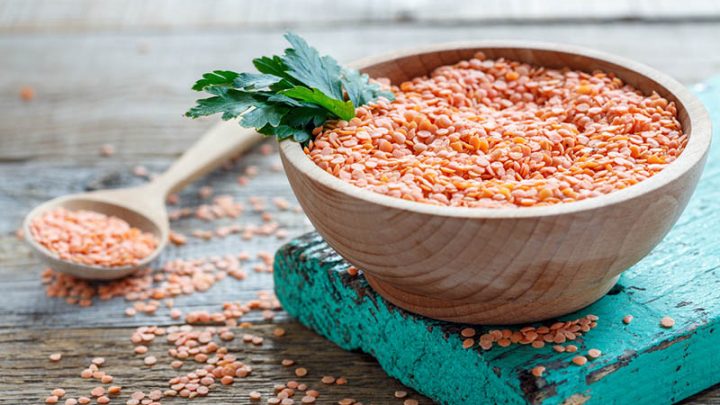When looking for baby food ideas for your little one, you probably came across lentils. But, are lentils for baby safe?
Despite their appearance, lentils for baby are okay to eat.
In fact, they’re actually fantastic as they’re nutritious and easy to swallow.
Also, unlike many other foods, they’re safe to be consumed when your baby is as young as 6 months of age!
This is because lentils don’t contain any dangerous allergens and are rich in iron and protein, both of which are crucial to a child’s physical and mental development.
You’ll also find lots of folates, vitamin C and B, as well as magnesium, packed among all the other good stuff.
There are countless infant food recipes involving lentils too, giving you plenty of options for how to prepare your child’s meals, from a bit of sauté action over medium heat to just throwing them in a food processor and making a puree.
This is only part of why lentils for baby are considered a great first food and I’m here to give you the full rundown as well as a few recipes.
When Are Lentils For Baby Safe For Consumption?
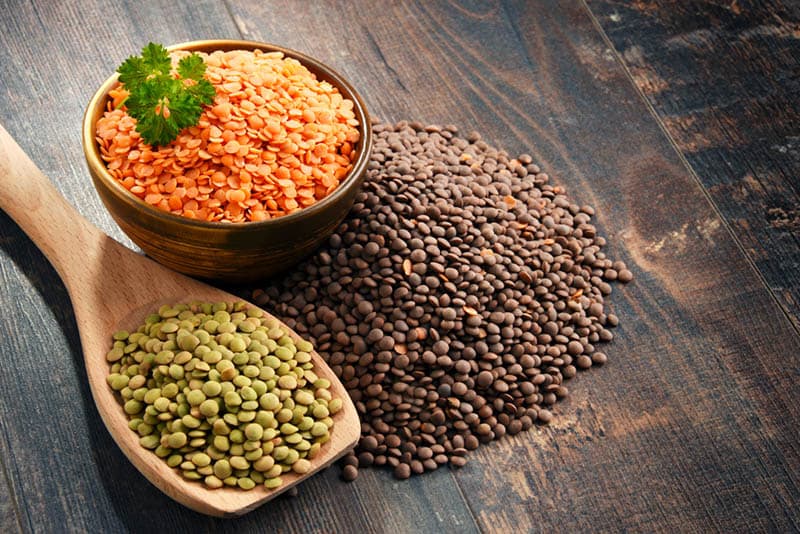
Some mammas in Asian countries introduce them to their kids as early as 4-5 months of age.
As far as the US is concerned, the general rule of thumb is to offer lentils around 6 months of age, give or take a few weeks, but it’s typically around the time your baby starts eating solid foods.
That said, don’t use time as the only factor to consider.
If you believe that your child might be ready to swap from breast milk or formula over to solid foods, schedule an appointment with your child’s pediatrician first so he can do a check-up.
If your child’s digestive system has developed far enough, the pediatrician will give you the green light to introduce your baby to yummy solids.
Health Benefits Of Lentils
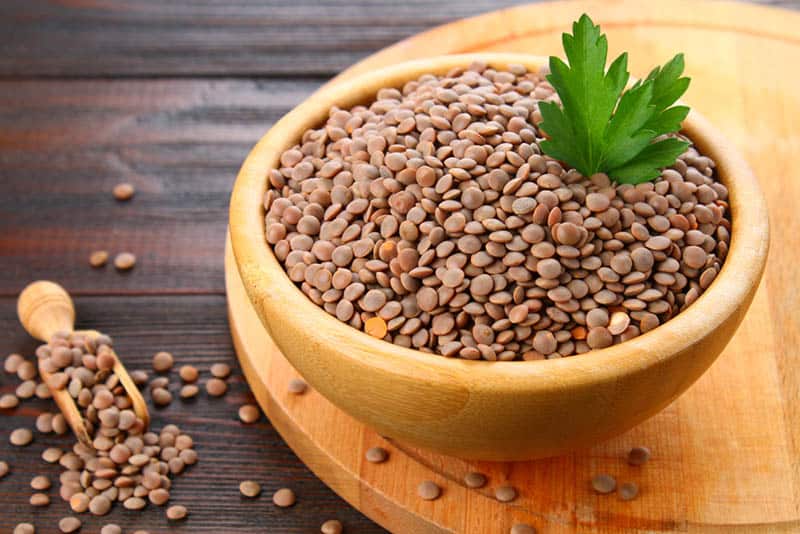
It’s a common misconception that lentils are risky when it comes to child safety because they might pose a potential choking hazard.
In reality, it depends on how you make them.
If the ingredients are properly cooked and completely softened before getting pureed in the blender, your kids will be more than fine.
However, when the baby purees aren’t liquid enough or if the spoonful is too big, the food might congeal in the baby’s mouth and pose a slight risk of choking.
This is usually as a result of ingredients other than lentils as more often than not when lentils have been involved in a choking incident, there have been common sticky foods, such as cheese, involved too.
The main benefit of lentils for baby is that they’re not a common allergen making them a good choice for your baby’s first food.
Of course, there are always exceptions and your child might be one of the rare people who end up with an allergy to lentils and other legumes since anything has the potential to be an allergen.
They’re an excellent food for baby-led weaning, especially when getting your little one off the breast or the bottle becomes an issue.
They’re also considered to be one of the best vegan alternatives to meat given their nutritive profiles, however, you may still decide to give meat food to your baby.
A mix of everything is always necessary to facilitate healthy growth and these “beans” definitely cover a wide array of nutritional benefits.
Firstly, they’re rich in fiber and help move things along inside the stomach, keeping your baby’s stool regular and helping prevent constipation.
Do be warned though, lentils can make your baby a bit gassy.
In this case, you might want to switch to other foods until your baby’s digestive system normalizes as gas might make him a bit fussy.
RELATED: 14 Best Formulas For Gassy Babies To Put An End To Crying
If you don’t want to pause the intake of lentils, have a bit of gripe water or gas drops handy for when it does happen.
Lentils are also rich in iron which is a must-have for kids older than 6 months as that’s around the time where the amount of iron required by the body starts to increase, usually leaving kids iron deficient.
This makes iron a crucial nutrient in your baby’s diet and our beany friends are here to help!
After all, your kiddo will need iron to keep his energy levels up as well as help develop his thinking capabilities.
Many members of the legume family are also quite rich in calcium which is something our body needs on a daily basis to help keep our bones strong.
This is especially true for kids as they need it to help facilitate bone growth.
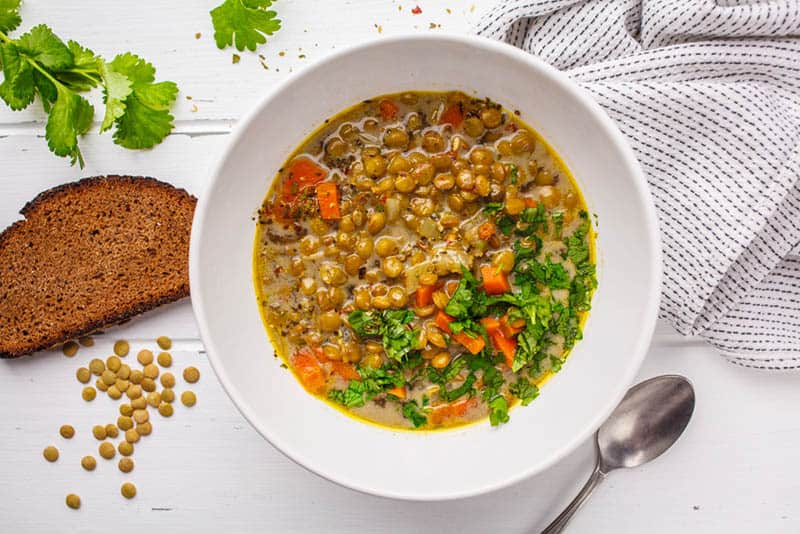
A strong immune system is important for kids to develop and maintain, it needs to be kept at a high enough level and the zinc found in legumes does exactly that.
It also helps in promoting brain activity which results in better memorization and improving cognitive ability.
Furthermore, the high polyphenol count found in this specific food family helps promote better health by further shielding the body from some potentially harmful and degenerative diseases.
The next noteworthy thing is the high dose of folates, a great nutrient that helps promote the creation of DNA and new cells in the body, resulting in healthy physical development.
Something else that might be more important for adults, but is a useful piece of info nonetheless, is that lentils help reduce cholesterol levels, minimizing the chances of potential stroke or heart disease and keeping your child’s cardiovascular system healthy.
To sum up, here’s a little list of the important nutrients and vitamins:
• Proteins
• Carbohydrates
• Rich in fiber
• Natural sugars
• Calcium
• Phosphorus
• Iron
• Magnesium
• Zinc
• Sodium
• Potassium
• Vitamins A, B-6, C, E, and K
• Folates
Aside from health reasons, this type of nutritional food is very easy to store too. It lasts up to a year when stored in a dry, cool place.
But that’s not all, if you make more baby food than your little one can handle, you can stick it in the fridge/freezer too and it’ll still be good when thawed on a bit of light heat.
It won’t lose any flavor and some kids even prefer the re-heated version over the initial batch.
What Kinds Of Lentils Are There?

While lentils come in many different colors, each with its own distinct flavor and nutrient profile, you’re most likely to encounter 3 different types on average, maybe 4-5 depending on the season.
The first kind that you’re likely to see are red lentils.
These are widely available and are arguably the easiest to cook as all you need is 15 minutes on the stove.
They’re also the suggested type of lentil for baby when it’s his first time eating some.
This is thanks to its sweet flavor, increasing the chances of your kiddo accepting it and broadening his palate.
They’re ideal for making any sort of soup or stew to add an extra bit of aroma and texture into the mix.
Next up we have brown lentils which are considered to be the budget option.
Unfortunately, they aren’t quite as flavorful as the other options, but they aren’t too bad on their own.
Just make sure not to overcook them so they don’t lose the little bit of flavor they do have.
You can always make a combo with spices, herbs, veggies, and other condiments when your kiddo is a bit older.
I recommend coriander, sweet potato, cumin, turmeric, etc.
Do try and avoid any of the stronger spices while your baby is still young and save those for when he’s older and can properly stomach them.
Prepping the beans with these additions also makes the homemade baby food more interesting so it doesn’t always come pureed.
If you’re looking for a slight in-between, you might want to give yellow lentils a go.
While not as sweet as the red variant, they still retain a lot more flavor than the brown ones.
Their flavor is a mixture of nutty and sweet, giving any stew a great taste that your child will appreciate.
Next up are green lentils which you might find on the market branded as Puy.
Apparently, these are the best a lentil can get!
They’re often added to salads and don’t get too mushy regardless of how long you cook them.
They have a rich taste, helping open your child up to different flavor profiles.
The final alternative is the black variant known as beluga.
They’re not used in baby food often and are usually added to salads rather than used in stews and soups.
You can also find them canned, but I don’t really recommend the canned version due to the potential of added preservatives, sugars, and salt.
This might ruin the flavor and increase the chances of upsetting your baby’s tummy.
Should You Avoid Lentils Because They Might Make Your Baby Gassy?

I’ve heard this question asked quite often and my honest answer is no.
There are alternatives if you’re that worried about it and you can easily switch to meat baby food among other options.
However, unless your child is allergic to legumes of any kind, I’d say welcome lentils into your baby’s diet!
The medical reason for the gassiness is related to the complex sugars that the body takes time to break down.
If the child’s digestive system isn’t suited for it, he’s likely to get bloated, gassy, and fussy.
If it’s causing too much of an issue, try lowering the amount you feed him or mix it with fruits and veggies to see if that makes it any better.
If it does, consider slowly increasing the amount over time to see if his digestive system gets used to it.
However, if the problem doesn’t seem to mend itself and it’s causing more harm than good, then you might want to consider other options.
Lentil Baby Food Recipes
As the last point of order, I’d like to present you with some great recipes where you can add this food gem.
They are easy to prepare and your kiddos will love them!
1. Baby-friendly lentil and vegetable puree

• 1 tbsp red lentils (rinsed)
• 2oz (1/4 cup) sweet potato, (make sure to peel the skin and dice beforehand)
• 2oz (1/4 cup) cauliflower (chopped up)
• 1 medium carrot, (wash, peel and dice up into tiny bits)
• 6 fl oz (3/4 cup) milk – (if using breast milk, the dish shouldn’t be re-frozen if thawed)
Firstly, you’ll want to rinse the legumes, then peel, and dice the remaining ingredients so their sizes are easier to blend later.
Once that’s done, mix all of them into a pan until the milk boils, medium heat is preferable.
After that, turn the heat down and let it simmer until the ingredients inside look properly ready, 15 minutes-ish for the legumes themselves and about half an hour for the vegetables.
When everything looks to be about the right color, take the pan off the heat, pour the contents into a food processor or blender, and set it to puree.
When it’s all turned into a nice paste, you’re good to go!
2. Baby-friendly Dal

• 4 oz (1/2 cup) red lentils
• a bit of oil (olive oil is preferred, but it’s personal preference really)
• 1 clove of garlic (crushed up so the juices leak out)
• 1 tsp of fresh ginger (grated finely)
• 16 fl oz (2 cups) of water
• 1 small onion (chopped up into tiny pieces)
• 1 small sweet potato
• 1/2 tsp cinnamon
• 1/2 tsp coriander
• 1/2 tsp turmeric
For this recipe, you’ll want to prepare the ingredients above before firing your stove up and heating the oil in a saucepan.
Put the onions in shortly after and sauté them for a bit until the juices are released.
Next, add the grated ginger and the crushed garlic and continue the process until the oil is infused with the garlic juices.
Over a period of 5 minutes, gradually add the rest of the spices, each of which is more or less optional depending on how well your child takes to them.
Slowly start adding the water while stirring, allowing the ingredients to balance out nicely before adding the main stars of the dish which are the sweet potatoes and lentils.
Let the mixture boil before simmering for the next half an hour, give or take depending on the type of legume used.
3. Apricot lentil soup
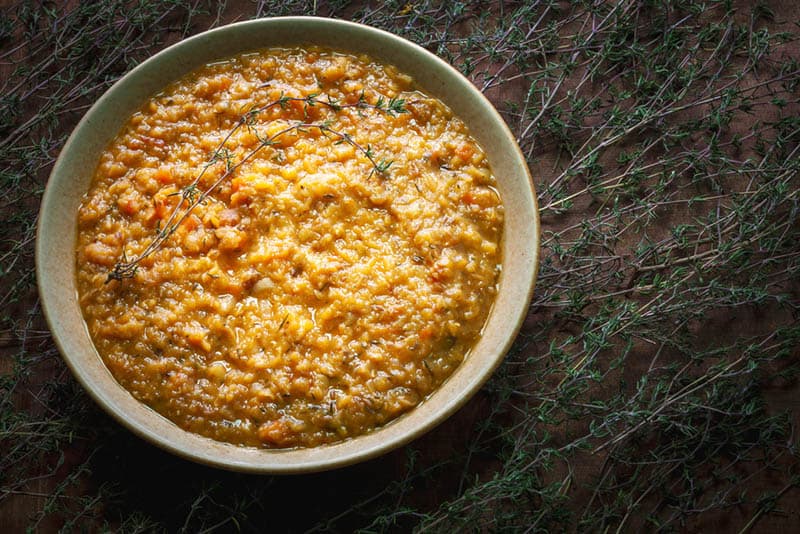
• A little bit of oil (olive oil preferred again, but personal preference)
• 8 oz red lentils
• 1 carrot (clean it, peel it and dice it up into tiny bits)
• 4 oz apricots (dried and chopped)
• 26 fl oz of water
• 1 small onion (dice it up into small pieces like the carrot)
• 1 tsp cumin (finely ground)
First things first, do the same as you did with the Dal prep, grab the pan, pour the oil in, and heat it up.
Add the onions shortly after the oil has heated, right before adding the carrots, and then sauté them until they get tender and release their juices.
Next, you’ll want to add the cumin into the mix slowly while stirring to let the mixture blend properly.
Once that’s done, turn it down to low heat and cover the pan with a lid to let them stew in their own juices for about 10 minutes.
Once ready, add the legumes in with the water so every ingredient is swimming.
Turn the heat back up and bring it all to the boil once more before lowering the heat again to let it simmer.
Wait for a good 25 minutes, give or take based on the type of bean you used. Add more water if necessary.
Once done, take it off the stove and allow it to cool off and settle.
Pour the mix into a blender, add the dried apricots as well as any extra water from the ingredient list, and set it to puree.
In Conclusion
As you can see, lentils for baby are quite healthy and have a wide variety of ways they can be prepared for your little one to enjoy.
They do come with the small caveat of the occasional bloating and a case of the toots, but it shouldn’t really be that big of a problem.
You can start your little one on these bean wonders as soon as he starts with his first solids.
This usually happens when your baby is around 6 months old, but always make sure to check with the pediatrician or any other healthcare professional first.
They’re the ones who can best assess whether your child is ready for something more complex than breast milk or formula.
Until next time, enjoy feeding your precious angel these nutritious and delectable meals, mammas!
Like this post? Please share or pin it for later. You can also stay in the loop and follow us on Facebook, Instagram or Pinterest.
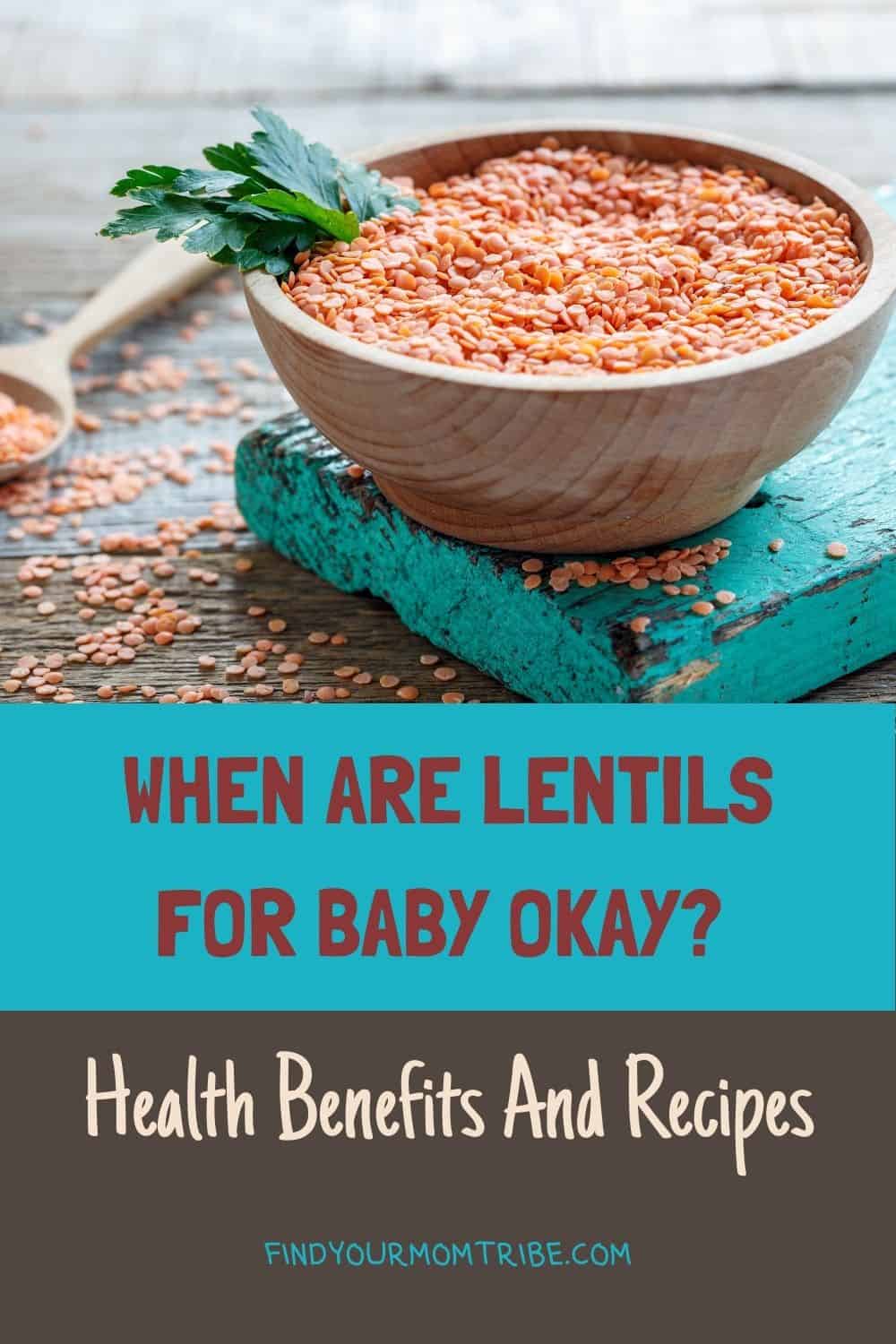
We love honesty! Find Your Mom Tribe is an Amazon Associate and we earn from qualifying purchases through affiliate links at no extra cost to you. Please see our full Amazon Affiliate disclosure for more information.

